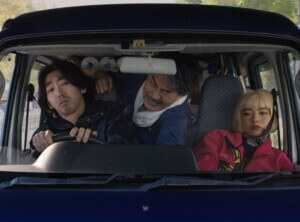“Black form” is a word interdisciplinary artist Zion Estrada uses to describe ulterior modes of knowledge transfer between folks in the African diaspora. In contrast to the “standard” media used to transmit histories, Black form evokes a communication system where stories about familial history, displacement, resistance, struggle and joy are transferred vis-a-vis “Black movement, Black practice, Black dance, Black hairstyle, Black silence, and Black noise.” At this year’s Chicago Architecture Biennial, themed This is a Rehearsal, Estrada and Black Reconstruction Collective (BRC)—founded by Olalekan Jeyifous, Amanda Williams, Emanuel Admassu, Germane Barnes, Sekou Cooke, J. Yolande Daniels, Felecia Davis, Mario Gooden, Walter Hood, and V. Mitch McEwen—debut UNMONUMENT CHICAGO: AFTER WORK where Black form takes center stage.
“The industrial lift we’ve adapted for UNMONUMENT resonates with my post-capitalist, salvage-punk ethos and serves as a collaborative platform that will enable the BRC to explore intersections of architecture, community, and the environment within the context of Black cultural practices,” Jeyifous told AN. His fellow cofounder, Amanda Williams, added that “With this work the BRC leaves the museum behind in search of another form for sharing our capacity to reconstruct the world around us and invite folks into that work.”
Zion Estrada’s forthcoming short film, 2,340 Miles from 1880, is her contribution to BRC’s exhibition in the Chicago Architecture Biennial. It collapses over a century of history on the Mississippi River by telling the story of African American work stoppages on Louisiana plantations, the Great Migration north to Chicago, and the moments of leisure, reflection, and joy that took place in between. 2,340 Miles from 1880 draws upon the archives of Homer McEwen, the great uncle of the BRC’s Mitch McEwen.
AN spoke with Estrada and McEwen about the film and BRC’s latest contribution to the Chicago Architecture Biennial.
AN: I’m looking forward to learning about the film, but first I’d like to talk about what’s new with Black Reconstruction Collective. What’s BRC been up to since its show at MoMA?
Mitch McEwen: As a collective, BRC started out by questioning institutions and how they can operate differently. And that includes us as well. So it’s sort of like we’ve been institutionalizing while having moments of retreat from institutionalizing.
The BRC has been awarding fellows grants so they can produce their own work. We’ve now had two cycles of fellows whose work was financially supported by BRC. We’ve also been doing lots of writing, and supporting each other’s individual practices. One project I’ve worked on is Floating Cipher, a Black gathering in the midst of the first Black-curated Venice Architecture Biennale. Since then we’ve been preparing for Chicago and working on UNMONUMENT which will travel to ten different sites after this one. As it travels, UNMONUMENT will engage with other practitioners in different sites around what we’re calling “Black America” because I’m hoping it doesn’t stick to the boundaries of the U.S.
Our ambition with UNMONUMENT is to host the work of people participating in BRC more broadly. So for me, it was really important that Zion be a part of this because of her important work on design in Black discourse and more broadly in the arts as a researcher.
AN: Zion, you worked with Mitch on the short film BRC is debuting in Chicago. I understand it as a sort of oral history taken from the Mississippi River’s 2,340 miles. Could you walk us through that project?
Zion Estrada: This film project starts with Homer McEwen, Mitch’s great uncle. I’d like to volleyball that question back to Mitch and then I’ll take it from there.
MM: Yeah, so my great uncle Homer McEwen’s papers are part of Amistad Research Center. He archived historical events, a bit of my own familial history, but much more so Black church organizing and local histories. The papers include his graduate school research on work stoppages on plantations in Louisiana. Homer’s research also took him to Chicago, and looked at what was happening in Black institutions and churches there around 1940. I think this project can be understood as a form of wayfinding, a search within a Black familial archive. That’s what I hope comes out of it.
ZE: When Homer’s archive was shared with me, we were already thinking about monumentality, and how to undo monumentality. We were having this conversation about if a monument could be a moment. Can a monument be a magical moment or an unbelievable human being?
I come from an abolition background. So I’m interested in different kinds of abolition, and how abolition can be used to change our understanding of what makes something monumental. So in Homer’s archives, we realized he was doing that. He was going through all of the untold histories that didn’t make their way into history books. His archives talk about slave rebellions across and along the Mississippi River. There were lots of rebellions right before the abolition of slavery and also directly after that most folks don’t want to talk about. They happened across parishes in Louisiana, specifically New Orleans that were so successful. We were really blown away by these stories notated by Homer.

Mitch and I have been reading through these archives intensively. I feel like at this point our WhatsApp chat has even become an archive! We’ve been studying the history of deep extraction from the Mississippi River, the history of the U.S. Army Corps of Engineers undoing the River’s natural meandering, and how that directly relates to the undoing of Black folks’ natural humanness.
AN: How does the film engage with this amazing history?
ZE: After I had some time to digest everything, this project became about me trying to the best of my ability to place Black folks and their full humanness without depicting slavery. So the images in the film are all ones that we’re really used to seeing when we see Black people, right? The challenge here was to make sure we see the river the way Black folks see the river; as both naturally and forcefully a liberated, communal space.
So the film tells the monumentality of work stoppage: times of stopping work, breaking dams, stopping traffic, redirecting the flow of traffic, causing flooding; Detroit and Watts in 1967 where folks were going around burning stuff, there’s a long history to that. These are things that have happened in Black and white communities for centuries. So it’s a nonlinear and fully flowing, meandering story.

The film also uses “found sound” from these moments of deep reconstruction, and the demolishing of Black neighborhoods in Chicago, the demolishing of New Orleans from the floods. It also uses found sound from the River delta’s binaural waves. So the film is as loud and as quiet as the Mississippi River itself. It has this natural calmness the first ten minutes which actually changes your nervous system. We also use a lot of gospel music I pulled from gospel singers on TikTok, and of folks that are just sitting in their living rooms with their friends.
We’re playing with this idea of how to remind people of this natural and meditative practice toward rebellion and work stoppage that can also be just as scary and fearful as a River, but also as calming. This was a challenge. It became about packing hundreds of years of violence into a meditative tone.
AN: Zion, can you tell me a bit about your artistic practice and background? It seems like you sort of do everything.
ZE: [chuckling] Mitch is smiling at me. I call myself an artist researcher with a dash of experimental filmmaking, which I consider a form of citation and research. I lean into the fact that my work is fully informed by my research practice, and how I use the visual medium of visual storytelling to link and reference folks to all of the histories and discourses Black folks specifically are having. A lot of my focus is within the Caribbean also, where my family’s from.
AN: Are you familiar with Chantal Akerman’s work? And her film D’Est? The premise of 2,340 Miles from 1880 reminds me of it.
ZE: I love her and she fully informs my work! Her storytelling, and also her love of violence, you know her ability to convey it.
AN: Jeanne Dielman!
ZE: Yes! But also Chantal’s love for humans, and how she tries her best to focus on a human story, which is what I try doing with Black folks. Black folks are always in context to something else, which means Blackness can’t exist without it being in relationship to anything. So for me, if I’m going to put Blackness in relation to something, it’s going to be the river, and how we’re in relationship with the land.
AN: I’d like to talk more about the film’s narrative implications. There’s this long standing white supremacist myth in the U.S. that African Americans were freed by Lincoln, when in reality there was a long history of slave rebellions and uprisings which led to abolition. W.E.B. Dubois of course engages with this history. Can you talk about which sources were helpful outside of Homer’s archives in telling this history?
MM: That’s important to talk about. We specifically started our project and mentioned in its title the year 1880 for a few reasons; but most clearly as a period distinct from the Civil War. There’s a lot of scholarship about abolition. But you know, when one system gets abolished, like the plantation slavery system, new systems appear like mass incarceration, right? So it’s more of a gradient.
Dubois’s book about Black Reconstruction is this sort of big history, while our research engages with things that are seemingly minutiae. Circling back to my great uncle Homer McEwen’s archives, and work stoppage, the plantation strikes in 1880 were some of the most significant, where folks stopped working to the point that plantation owners—to them, nothing had changed—brought in the National Guard. One of the reasons Homer wrote about these strikes so extensively is because there was actually no violence. This makes them distinct from Nat Turner’s rebellions during chattel slavery.
To your question about narrative, we’re often told this story about progress that goes like this: The south was economically backwards and there was more opportunity in the north, where there were supposedly more political freedoms and jobs. The history of work stoppages actually completely rewrites this history. It opens the possibility that in Chicago there was a continuation of not working. Chicago, as we know it, doesn’t exist without the Great Migration of Black folks. But the Great Migration, as far as I’m aware of, doesn’t have any monuments to it.

ZE: I’d like to add to that. One thing I loved about this research is learning about what happened during the work stoppages that we never really hear about. What were Black folks doing when they stopped working on plantations in 1880? They had an opportunity to braid their hair, time to just sit and actually do nothing. They had the opportunity to maybe hug their loved ones. Maybe they partied. Or maybe they were planning and strategizing. Just imagine, five generations of your family have been worked to the bone, and your entire body has been used as a tool, a machine, for these plantations. That new leisure time gave people the chance to collectively dream.
This is the moment where people started to collectively dream of the Great Migration, and they could also rest. This allowed them to do what their body is supposed to do, which is to move toward liberation and freedom. Just like what we kind of had in 2020, and during COVID-19; many people had space to shift their thinking. What was also amazing was how trickles of information and strategy entered New Orleans during that time from Haiti, and the Haitian Revolution. It was from this space of rebellion and work stoppage that information was shared across the country. I think there’s really something beautiful about that.
But there’s also part of me that’s like, okay, it might be time for us to sit down and dream again, and reimagine something else. Because if we’ve been doing the same thing since 1880, and nothing’s quite gotten us fundamental change. I won’t say that nothing has changed, but it feels like we need another moment where we can tap into that Black ingenuity. What will the next form be? What will it look like and who’s going to inform it? What will it take to push us into another one of these epics after decades of migration?
2,340 Miles from 1880 is on display between November 3 and November 25, 2023 at Blanc Gallery.











